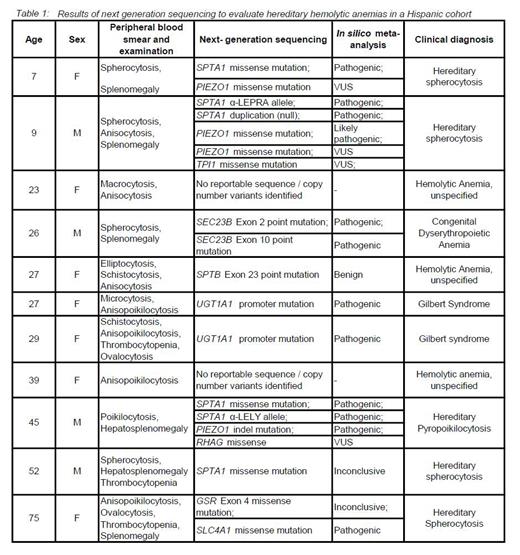Background:
Hereditary hemolytic anemias (HHA) are a heterogeneous group of nonimmune disorders characterized by increased red blood cell (RBC) destruction due to abnormalities of hemoglobin stability, defects of RBC metabolism, and disorders of RBC hydration. Although uncommon, they comprise important causes of anemia in children and adults by causing chronic or episodic hemolysis. Clinical, laboratory, and genetic heterogeneity characterize this group of disorders and make recognition challenging. The advent of next generation sequencing (NGS) has made accurate genetic diagnoses attainable, with an increasing number of studies reporting clinical utility in HHA. For patients with suspected HHA, multigene testing is available incorporating an NGS panel associated genes. However, there is limited data on the use of multigene NGS to characterize HHA in the Hispanic population. Herein, we describe results from NGS testing of a pilot cohort referred for HHA investigation to hematology clinics along the US/Mexico border.
Methods:
Pediatric and adult hematology clinics at Texas Tech University in El Paso, TX collaborated for testing on HHA referral and clinical case review. The diagnostic panel (AnemiaID/PerkinElmer/Revvity®) included 51 genes encoding RBC cytoskeletal proteins, membrane transporter, RBC enzymes, and certain bilirubin metabolism genes. The complete coding region, splice site junctions, and, where appropriate, deep intronic or regulatory regions were covered. Targeted gene capture and library construction for NGS were performed using a Whole Blood and Saliva kit and 150 base pair paired-end sequencing was done on Illumina® NGS systems at target average coverage of 80×. NGS output data were summarized descriptively for all patients and clinically correlated for diagnosis.
Results:
In this pilot cohort, 11 patients were tested during September 2022 to June 2023, age ranging 7-75 years, with females accounting for 64% of the group. Findings are reported in the Table below; Pathogenic variants leading to a definitive diagnosis were identified in 8 of 11 cases (73%). The most frequently mutated genes were SPTA1 followed by PIEZO1, SPTB, RHAG, GSR, SLC4A1 and TPI1. Approximately 58% of the mutations were reported as novel. Diagnoses included, most commonly, Hereditary Spherocytosis followed by Hereditary Pyropoikilocytosis and Congenital Dyserythropoietic Anemia. Compound heterozygosity leading to complex interactions was noted in 4 cases (36%), involving SPTA1 low expression alleles in trans (alpha-LELY and alpha-LEPRA) in 2 cases.
Conclusion:
Hereditary hemolytic anemia in the Hispanic population is characterized by complex molecular interactions and a high prevalence of novel mutations in RBC cytoskeleton/enzyme genes. NGS has clinical utility and should be considered for accurate diagnosis. Further research into the molecular basis and genetic spectrum of HHA in the Hispanic population is needed.
Disclosures
No relevant conflicts of interest to declare.


This feature is available to Subscribers Only
Sign In or Create an Account Close Modal